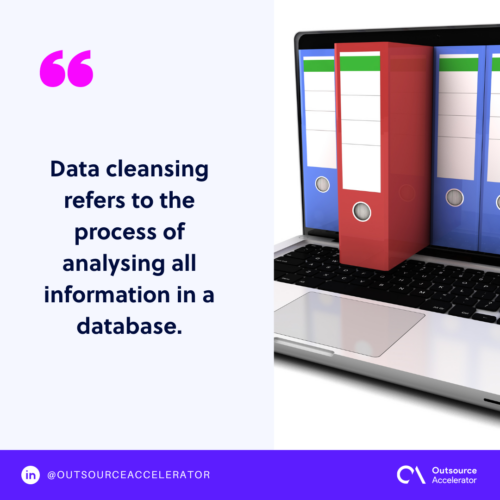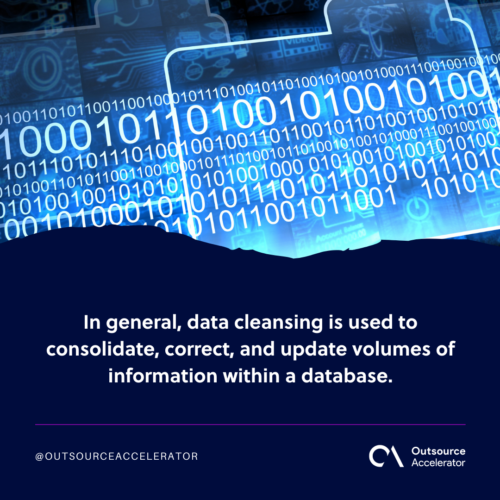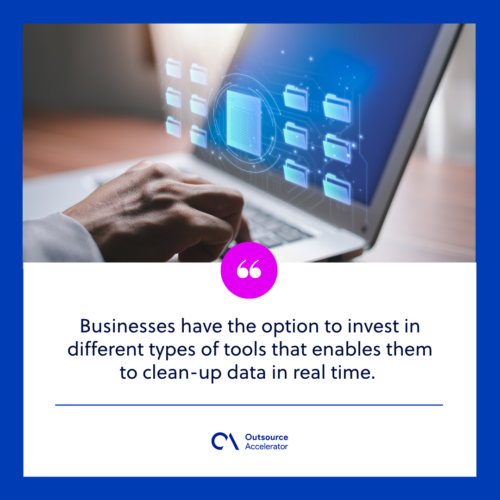The science of data cleansing: Why does it matter?

Before, we were used to storing tons of important files in safe boxes or file storage drawers for safekeeping.
Our modernized era today has made information storage easier and safer through the use of technology.
Today, businesses collect and store various consumer data from multiple sources as they conduct daily operations. These customer records could include personal information, product listings, phone numbers, zip codes, and employee details.
Yes, it is much easier to store information in a database. However, the safety and security of all data are crucial factors that should be considered in data management.
This is why it is highly important to perform data cleansing every once in a while.
What is data cleansing?
Data cleansing refers to the process of analyzing all information in a database. From there, all duplicated, incomplete, irrelevant, inaccurate, or incorrectly formatted data sets are removed or updated.
Data cleansing is one method of data management. As time passes, businesses or individuals may collect thousands of information that are:
- Inconsistent data
- Incomplete data
- Corrupt data
- Irrelevant data
- Dirty data
The data cleansing process on years of stored information can take quite a while to complete. This is why it is vital to use data cleansing tools to keep all information consistent and up-to-date.

Importance of data cleansing
In general, data cleansing consolidates, corrects, and updates volumes of information within a database. This helps ensure that the system used is free of the following and will function effectively:
- Missing values
- Typographical errors
- Duplicate values
- Structural errors
- Syntax errors
More so, data cleansing is an essential process for both individuals and businesses.
Importance of data cleansing for individuals
It is normal for individuals, especially professionals to keep personal information on different files in their personal computers.
Piling up different files like tax, banking, mortgage, credit card information, and legal papers for years can be overwhelming. This can also lead to disorganization, thus it can cause the device to function slowly.
Data cleaning makes it easier to find specific paperwork, helps individuals keep their files organized, and prevents document loss.
Importance of data cleansing for businesses
Businesses typically have volumes of personal information from clients, employees, customers, and more.
Data cleaning allows them to maintain accurate and updated records, helping maintain high-quality data. For example, it is easier to look for customer details if their database is well organized, which in turn enhances their productivity.

Benefits of using data cleansing tools
Using data cleansing tools brings the following advantages to organizations:
Improved efficiency
Having clean and precise data does not just help a company’s external needs. It also helps organizations gain valuable insights into internal processes and employee performance.
One example of this is when companies make use of data to evaluate employees or determine job satisfaction.
The HR department may perform data cleansing on employee feedback, reviews, and evaluations. This is to determine which business function or department is at a high risk of attrition.
Enhanced decision making
Having correct data makes decision-making for business leaders easier. Accurate and updated information helps organizations plan and calculate effective strategies for growth and development.
Competitive advantage
Data cleansing allows companies to have complete and organized data, especially when it comes to customer information.
It reveals insights into the latest trends, and it helps businesses understand their customers better.
5 steps in the data cleansing process
Here are five steps to follow in performing data cleansing:
1. Check for errors
It is important to monitor and track which parts of the data usually have errors. Doing this makes it quicker and easier to distinguish and correct mistakes in specific information.
2. Standardizing your data
Data must be standardized in order for data cleansing to be effective and easily replicated. Thus, it is also vital to stick to the standardized data rules as it helps data management smoother and easier to keep control of.
3. Data validation
Once data cleansing is done, the next step is data validation. This also determines the accuracy of stored sets of data.
Businesses have the option to invest in different types of tools that enables them to clean-up data in real time. There are also tools that are powered by Artificial Intelligence (AI) and machine learning.

4. Scrub off duplicate data
Scrubbing off duplicate data is also essential, as this helps organizations save valuable time when analyzing large amounts of information.
Data tools can also be used for this process. They process the raw data and automate the process. This helps eliminate manual work and lessens the risks of committing errors.
5. Evaluate data quality
After standardization, validation, and deduplication have been completed, the last step is to analyze the data quality.
It is crucial to analyze the health of the data as it can also help enhance each organization’s data cleansing procedures.
One effective option is partnering with third party solutions providers with seasoned data management experts such as Sourcefit.







 Independent
Independent




